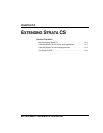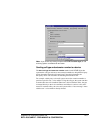
14-6 STRATA CS ADMINISTRATOR MANUAL
BETA DOCUMENT - PRELIMINARY & CONFIDENTIAL
The possible combinations of DTMF digits that are sent to the device are
described in the following table.
The following example illustrates one way that Strata CS can be configured to
send DID digits to stations:
n Frank Smith is assigned extension 101. Miri Anatolia is assigned
extension 102.
n A third-party voice mail system is attached to several Strata CS stations.
The system administrator creates a user for each device and assigns each
one an extension, as in “Voice Mail Port 1” at extension 301, “Voice Mail
Port 2” at extension 302, and so forth. When setting the Send digits to
station
option for each user, the system administrator selected Send call
type and extension number
. Finally, each voice mail port is added to a
workgroup called Voice Mail, at extension 300 (for more on setting up
workgroups, see “Creating a Workgroup” on page 7-3).
n Both Frank and Miri have a routing list that rings them first at their own
extensions, and then sends calls to the workgroup Voice Mail at extension
300. Any calls for Frank and Miri that they do not pick up go directly to
the first available voice mail port in the workgroup.
Type of call DTMF digits sent
Direct call to this extension from an external
caller.
“1”
Direct call to this extension from an internal
caller at another Strata CS source extension.
“2{source extension}#”
Call from an external caller to a different
target extension.
The call was sent to this extension via a
routing list action because the target
extension was busy or the call was not
answered.
"5{target extension}#"
Call from an internal caller at another source
extension to a different target extension.
The call was sent to this extension via a
routing list action because the target
extension was busy or the call was not
answered.
"6{target extension}#
{source extension}#"


















